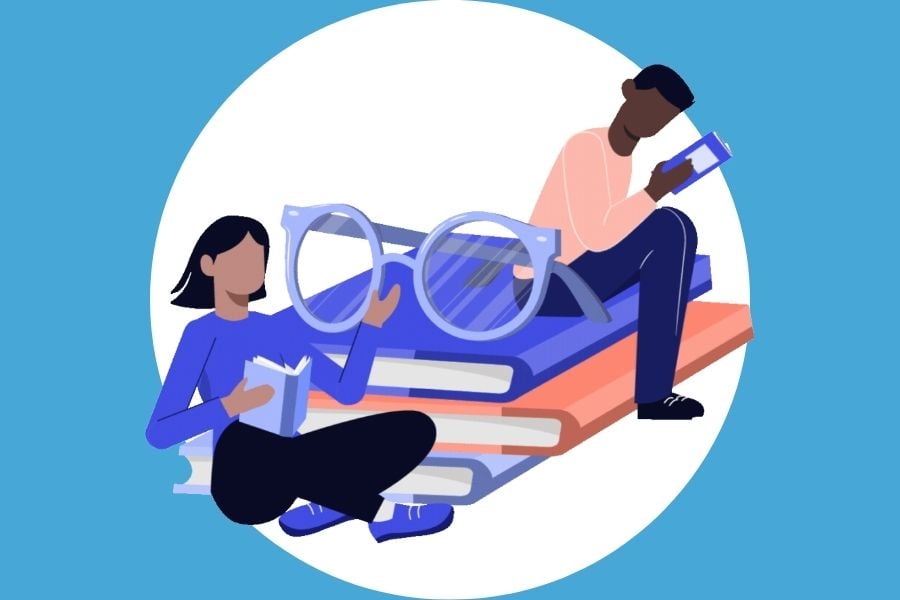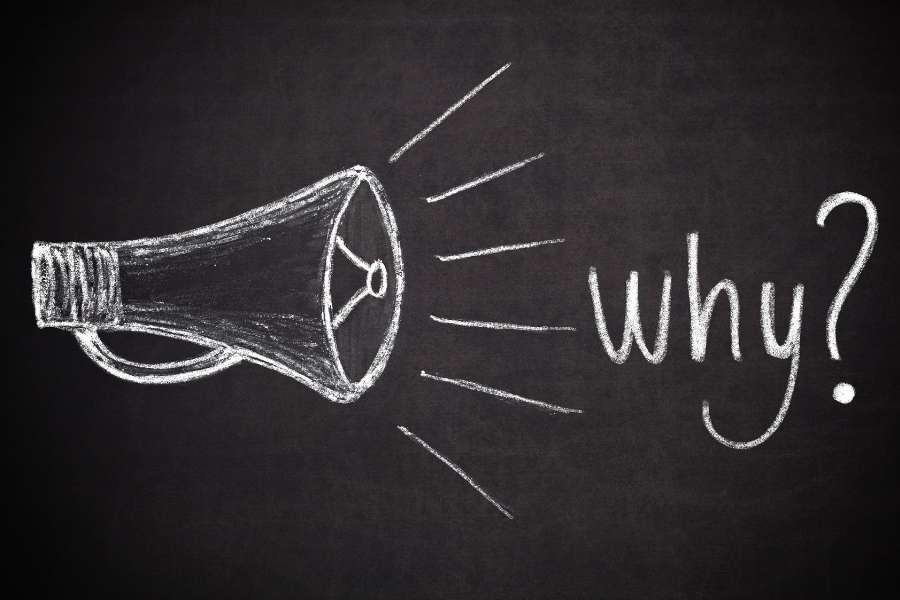Are you looking for some point of view examples?
Whether you’re telling a story or studying one, understanding how point of view (or POV) is critical.
The same events, narrated from a different POV, narrator, or perspective, can come across differently.
Imagine Pride and Prejudice told from Darcy’s point of view, for instance — or the Sherlock Holmes stories narrated by Sherlock instead of Watson.
In this post, I’ll clarify what exactly POV is, examine some examples, and explain why a point of view is crucial in both literature and poetry.
Ready to dig in?
Let’s begin.

So What is Point of View Anyway?
The “point of view” or “viewpoint” in literature relates to the character or narrator who tells the story.
You might think of this literary device as a camera angle: what can the storyteller see?
Point of view is usually first person (“I”) or third person (“he/she”). And occasionally, you will stumble upon second person (“you”).
Common Point of Views That Every Skilled Writer Must Master

Whether tackling a creative writing project, whitepaper, blog post, or short story, you’ll need to understand the different points of view and when to use each pronoun.
Below we’ll define each, show you some examples, and discuss how it impacts your writing.
First Person Point of View
The 1st person point (using “I”) is a classic way to be a narrator to a story: with a main character narrating the events that have happened or are happening to them.
1. Jane Eyre, Charlotte Brontë (1847)
“I was glad of it: I never liked long walks, especially on chilly afternoons: dreadful to me was the coming home in the raw twilight, with nipped fingers and toes, and a heart saddened by the chidings of Bessie, the nurse, and humbled by the consciousness of my physical inferiority to Eliza, John, and Georgiana Reed.”
First-person lets you:
- Create instant sympathy for your main character who is telling the story.
- Use an unreliable narrator, who the reader suspects or discovers is not relaying events accurately. (The book and the film Fight Club are good examples of this.)
- Use highly evocative and figurative language, as the comparisons and descriptions come directly from the character’s unique perspective.
- Develop a unique, strong narrative voice: try The Observations by Jane Harris to see this in action.
First Person Peripheral
The 1st person peripheral involves a narrator who isn’t the main character or one of the main characters.
2. A Study in Scarlet (Sherlock Holmes), Arthur Conan Doyle (1887)
“Of contemporary literature, philosophy and politics, he appeared to know next to nothing. Upon my quoting Thomas Carlyle, he inquired in the naivest way who he might be and what he had done. My surprise reached a climax, however, when I found incidentally that he was ignorant of the Copernican Theory and of the composition of the Solar System.”
First-person peripheral lets you:
- Preserve an air of mystery about your main character (as Watson’s narration does for Sherlock or Nick Carraway’s narration does for Gatsby in The Great Gatsby).
- Keep secrets from the reader — often about the backstory or a character’s plan.
- Tell a first-person narrative about a character who dies during it.
Second Person Point of View
Second person point (using “you”) is a highly unusual way to tell a story. It’s more common in poetry — which we’ll discuss in later examples.
3. The Fifth Season, N.K. Jemisin (2015)
“He walks you outside and down the block, keeping a grip on your elbow the whole time. A few others are gathered on the street outside. Some of them come near the two of you, saying things to which Lerna replies; you don’t really hear any of it.”
This excerpt demonstrates how the second person point of view can create an immersive experience, pulling the reader directly into the story.
But the second person perspective is a narrative best handled with care. It’s worth experimenting with for short pieces, but it’s hard to manage effectively over the course of a whole book.
Typically, the first person point of view will work better over second person narration.
Third Person Limited Point
The 3rd person limited (he/she) perspective became extremely popular during the 20th century. It is a subjective person narration, not to be confused with third person objective; you have direct access to the 3rd person’s thoughts.
4. Harry Potter and the Sorcerer’s Sone, J.K. Rowling (1997)
“It looked as though Dudley had got the new computer he wanted, not to mention the second television and the racing bike. Exactly why Dudley wanted a racing bike was a mystery to Harry, as Dudley was very fat and hated exercise – unless of course, it involved punching someone.”
The Harry Potter books primarily use the third person limited point of view, with only Harry’s thoughts and observations being shown (not Ron’s or Hermione’s).
Third person limited point of view has become a highly popular choice used by both literary and genre writers. It’s very useful for:
- Telling a story with a slightly greater degree of distance and objectivity than a first person POV narrative would allow.
- Withholding information about what other characters are doing can lead to surprises and make the story more interesting.
- Dipping into the character’s thoughts (read the opening of Ray Bradbury’s Fahrenheit 451 for an example).
Third Person Omniscient
The third person omniscient point of view (or omniscient narrator) is a detached viewpoint, often describing far-reaching events or zooming in on different characters.
Omniscient is the most open and flexible perspective. As the name states, omniscient is “all-seeing and all-knowing.” It’s a narrative point that offers an “all-knowing” perspective in the story.
5. Brave New World, Aldous Huxley (1932)
“Bent over their instruments, three hundred Fertilizers were plunged, as the Director of Hatcheries and Conditioning entered the room, in the scarcely breathing silence, the absent-minded, soliloquizing hum or whistle, of absorbed concentration. A troop of newly arrived students, very young, pink and callow, followed nervously, rather abjectly, at the Director’s heels.”
A third person omniscient narrator is sometimes seen as old-fashioned, but it’s still an important part of modern writers’ toolkits. It can:
- Quickly give the reader the background information they need. (The first chapter of Harry Potter and the Sorcerer’s Stone does this.)
- Use descriptive and figurative language to describe characters’ thoughts and feelings, even when the characters themselves might not be aware of them.
- Set a certain tone or mood – for example, George Orwell’s “1984” uses a third-person omniscient narrator to create a sense of an all-seeing, all-knowing presence.
- Tell a complex story that deals with big events.
- Show the reader things (omniscient viewpoint) that no character can directly observe.
Third Person Multiple
Third person multiple allows the author to switch from a different character continuously, showing multiple viewpoints and a different perspectives.
6. The Long Way to a Small, Angry Planet, Becky Chambers (2014)
“[Ashby’s point of view] Ashby focused on the scrib, trying not to laugh at the memory of the last time Jenks had hacked into Corbin’s scrib, replacing the algaeist’s careful notes with three-hundred-and-sixty-two photographic variations of Jenks himself, naked as the day he was born.”
“[Rosemary’s point of view] Rosemary got the impression that for all his bluster about the rules, Corbn didn’t actually have any authority over the techs.”
Third person multiple can:
- Give a more rounded picture of all the characters, seen from multiple perspectives.
- Create a more complex plot: not all the characters will know everything, but the reader can piece things together. (Big Little Lies, by Liane Moriarty, uses multiple third person POV narratives in this way.)
- Develop sympathy for different characters’ ideas, personalities, and challenges.
Why Point of View is Important?

Now you understand the different types of points of view, let’s jump in and find out why they are essential…
Narrative Distance
Choosing the right point of view involves choosing the right narrative distance for your story: the space between the reader, the character(s), and the events of your story.
A strongly voiced 1st person point of view brings the reader in very close; a 3rd person omniscient narration (and third person point of view) gives a much greater distance. Whereas a 2nd person point of view falls in the middle.
Reader Perception
What does your reader think of your characters? What is their perspective? Can they clearly understand the story you’re telling? The point of view decisions you make will significantly impact the reader’s experience.
If you want to develop sympathy for a deeply flawed character, making them a first person or a third person limited narrator helps immensely.
Atmosphere
The novel’s atmosphere — how it feels to the reader — is also impacted by the point of view.
An omniscient narrator might add to an atmosphere of darkness or menace, reporting on dangerous events that the characters have yet to recognize. A 1st person narrator might lend the story a humorous, cheerful mood. Or the 2nd person will lend to a sense of detachment — a limited point of view.
Points of View in Poetry: 3 Tips to Strengthen Those Verses
Poetry is often written from a first person viewpoint — and this perspective is typically called the “speaker” rather than the “narrator.” The point of view may shift during the poem, and the “I” may or may not speak for the author.
Try these tips in your own poetry…
Slowly Reveal Information Using the “I” Point of View
Using the first person point of view for your whole poem can be a great way to slowly uncover information — not just for the reader but also for the speaker. This can create a sense of irony, progression, or empathy from the reader.
7. Because I Could Not Stop For Death, Emily Dickenson (1863)
“Because I could not stop for Death –
He kindly stopped for me –
The Carriage held but just Ourselves –
And Immortality.”
This short poem ends with the speaker looking back on the centuries that have passed, saying that they still “Feel shorter than the Day/ I first surmised the Horses’ Heads/Were toward Eternity.”
Consider Third Person for a Narrative Poem or Children’s Poem
If you’re writing a children’s poem or a narrative poem — that tells a story — then using third person narration can often work very well.
8. Goblin Market, Christina Rosetti
“Morning and evening
Maids heard the goblins cry:
“Come buy our orchard fruits,
Come buy, come buy […]”
[…] Evening by eveningAmong the brookside rushes,
Laura bow’d her head to hear,
Lizzie veil’d her blushes”
This poem tells the story of Laura and Lizzie; Laura, who is tempted by the fruits of the “goblin men,” and Lizzie who “stood/in deadly peril to do her good/And win the fiery antidote.”
It’s a complex poem to interpret: scholars still debate whether it’s an analogy for sex, drug abuse, or something else.
Write Your Poem as a Monologue or Conversation
Some poems are presented as monologues (one character speaking) or as conversations between characters. This can be particularly effective in short, humorous pieces.
9. Anniversary, Brian Bilston
“I forgot, I said,
but since when was our love built
on anything so ordinary
as a date?”
This poem has the narrator speaking until the final stanza, justifying the forgetting of an anniversary at some length — only to be rebuffed in the final stanza with, “And you said,/what do you mean,/you forgot?”
How to Choose a Point of View in Writing

How can you choose the best point of view for a piece of writing?
Consider your genre. Your genre may push you to select a particular point of view because it’s what readers will expect. Young Adult and New Adult romance novels, for instance, are almost always written in the first person.
Consider your personal preferences and what point of view comes naturally to you. Perhaps you love to dig deep into one character and tell their story from a 1st person perspective — or maybe you prefer multiple 3rd person limited points of view. Or maybe you want give the reader a bird’s eye view by using third person omniscient POV.
Be open to shifting your point of view decision during the writing process. Try drafting a scene from the first person instead of the third person point of view, or vice versa. Which do you prefer? Which works best?
Try using multiple different points of view. You can shift between other points of view in the same work, perhaps incorporating first person diaries and letters into a third person limited novel.
Studied Our Point of View Examples? Now It’s Your Turn
Whether you’re a literature student seeking to understand an author’s point of view decisions or a novelist looking to deepen your knowledge of your craft, our point of view examples should help.
Go back to a recent story or poem you’ve read. Can you identify the point of view or perspective the author has taken? What difference would it make if the author had made a different choice?
If you’re a writer, take a piece you’ve already written, and try changing the point of view. How does this alter your story?
Don’t be afraid to experiment with your perspectives: you might find this inspires a whole new piece of work.




